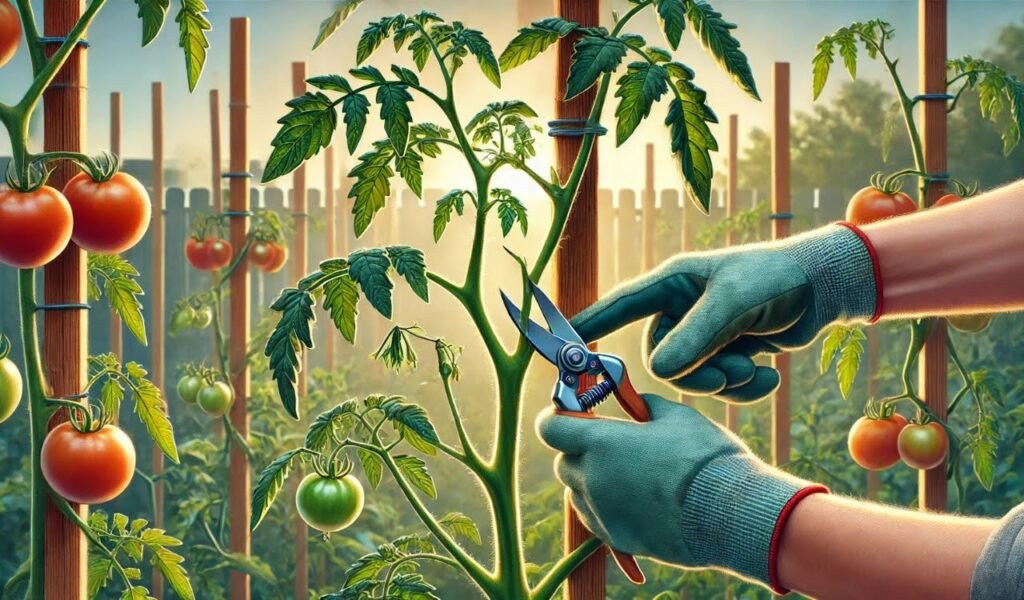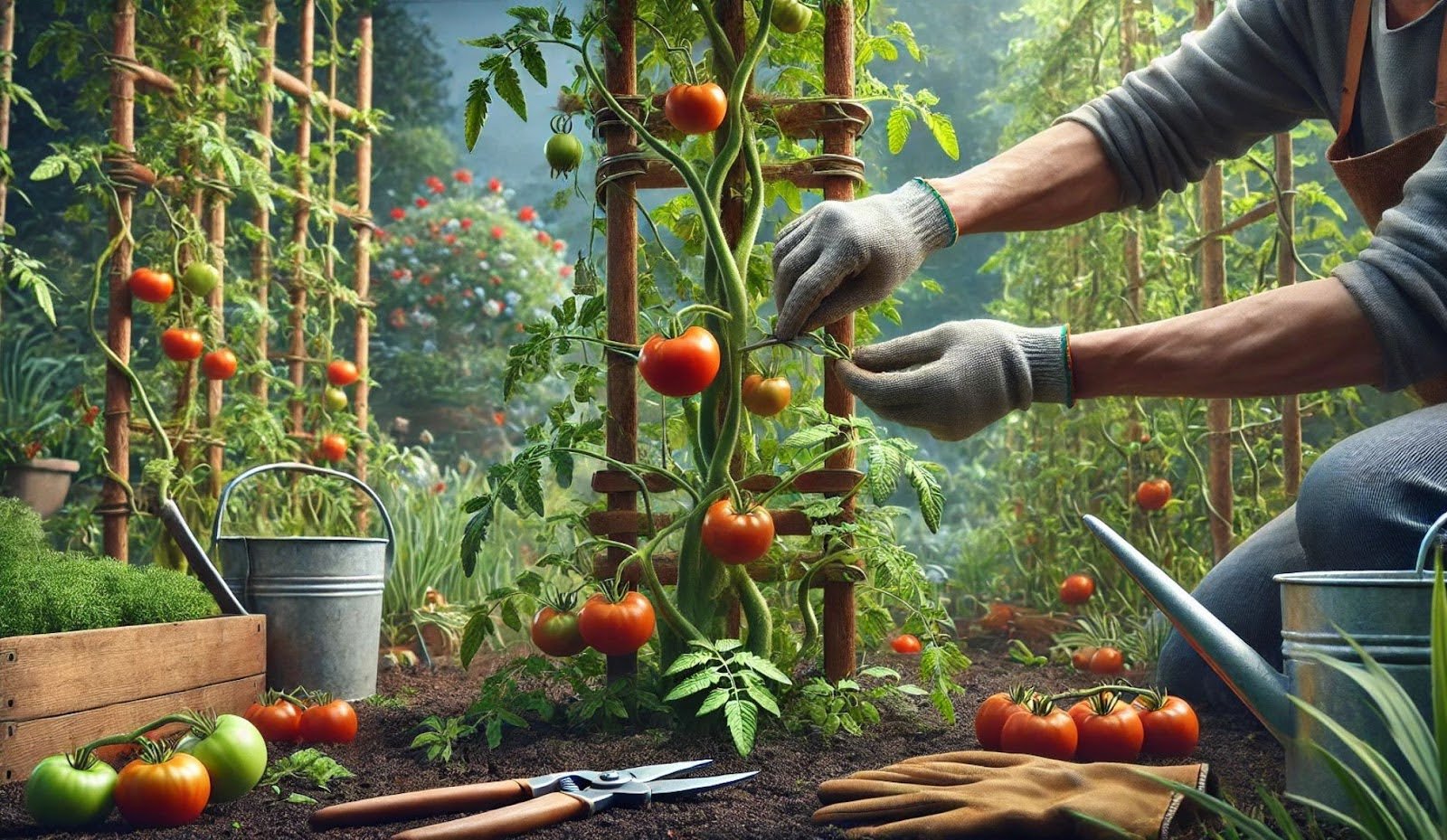How to Sucker a Tomato Plant: A Step-by-Step Beginner’s Guide
How to sucker a tomato plant might sound like a gardening mystery, but it’s easier than you think—and totally worth it. Suckering helps your plants focus their energy on producing bigger, tastier tomatoes instead of wild, leafy growth. Want to know the best part? It takes just a few minutes, and the results are impressive. Whether you’re a seasoned gardener or a first-timer, this simple technique can make a big difference. Stick around, and I’ll show you exactly how to do it like a pro!
What is Suckering?
Before you know how to sucker a tomato plant, you should know what sucking is. Suckering refers to the process of removing unwanted side shoots (called suckers) that grow in the leaf axils of tomato plants. These are the small shoots that sprout between the main stem and the branches.
While these suckers can develop into full branches, they often divert energy away from the plant’s primary goal: producing high-quality, flavorful tomatoes. For beginners, identifying a sucker might be tricky. Picture a “V” where the branch meets the main stem—suckers grow right in the middle of that “V.” Removing these not only streamlines the plant’s growth but also helps in maintaining its health.
Why use tomato suckers?
Using tomato suckers is a great way to propagate plants, especially tomatoes that are so easy to work with. Tomatoes produce plenty of side shoots that we need to cut anyway, so why not use them? It’s the perfect solution! You can grow the plants in the spring to produce a harvest in summer.
Some also use suckers in order to overwinter smaller tomato plants of varieties that produce an early harvest indoors. Or to simply get a good start with already developed plants instead of sowing new seeds. Experimenting is fun!
Benefits of Suckering Tomato Plants
Suckering provides several benefits that directly impact plant health and yield:
Enhanced Air Circulation
By removing excess foliage, you create better airflow around the plant. This reduces humidity, which is a common breeding ground for fungal diseases like blight and mildew.
Improved Fruit Size and Quality
When suckers are removed, the plant directs more energy to its primary stems and fruits. This results in larger, juicier tomatoes, rather than a plant overloaded with smaller, less flavorful fruits.
Easier Pest and Disease Management
A pruned tomato plant is easier to inspect for pests like aphids or hornworms. It also minimizes hiding spots for insects, making pest control more manageable.
Understanding Tomato Plant Structure
To effectively sucker a tomato plant, it’s important to understand its structure and growth patterns.
Key Parts of a Tomato Plant
- Main Stem: The central stalk that supports the plant.
- Branches: Grow out from the main stem and bear leaves and flowers.
- Suckers: The side shoots that emerge from the junction of the main stem and branches.
Determinate vs. Indeterminate Varieties
Determinate Tomatoes: These plants grow to a fixed size, and most of their fruit ripens at once. Suckering is minimal for these varieties, as over-pruning can reduce the yield.
Indeterminate Tomatoes: These continue growing and producing fruit throughout the season. Regular suckering is essential to manage their vigorous growth and prevent overcrowding.
Knowing which type of tomato you’re growing helps tailor your suckering approach for the best results.
Tools and Preparation
What You’ll Need
- Pruning Shears: For clean cuts on larger suckers.
- Gloves: To protect your hands from the plant’s rough surfaces.
- Disinfectant: To sterilize tools and prevent disease spread between plants.
When to Sucker Tomato Plants
The best time to sucker tomato plants is:
Early Morning: Plants are less stressed, and the cuts heal faster.
Growth Stage: Start when the plant is about 12–18 inches tall. At this stage, suckers are easy to spot and remove without harming the plant.
Regular maintenance every 7–10 days ensures the plant remains manageable.
Step-by-Step Guide on How to Sucker a Tomato Plant

Step 1: Identify the Suckers
Look for shoots growing in the “V” between the main stem and branches. Suckers often have smaller leaves than the main branches.
Step 2: Decide Which Suckers to Remove
For indeterminate varieties, remove most suckers but leave one or two near the base to form secondary stems for additional fruit production. For determinate varieties, only remove suckers that crowd the base or interfere with airflow.
Step 3: Remove the Suckers
Small Suckers: Pinch them off with your fingers. Use gloves to avoid plant sap irritation.
Larger Suckers: Use pruning shears for a clean cut. Disinfect the shears between cuts to prevent disease.
Pro Tip: Leave a small nub (1/4 inch) when cutting to reduce the risk of infection.
Common Mistakes and Troubleshooting
1. Over-Pruning
Removing too many suckers can weaken the plant and reduce its ability to photosynthesize.
Solution: Always leave enough foliage to protect fruits from sunscald and support growth.
2. Ignoring Key Suckers
Allowing too many suckers to grow results in a crowded, bushy plant that’s hard to manage.
Solution: Monitor plants weekly to maintain balance.
3. Tips for Recovery if Mistakes Happen
If you’ve over-pruned, provide extra care by watering and fertilizing regularly to help the plant recover.
Consider adding shade during hot days to reduce stress.
Additional Tips for Healthy Tomato Plants
Staking and Support: Use stakes, cages, or trellises to support the plant after suckering. This prevents stems from breaking under the weight of the fruit.
Watering and Mulching: Water deeply and consistently to prevent blossom end rot. Apply mulch to retain soil moisture and suppress weeds.
Fertilizing: Use a balanced fertilizer to replenish nutrients. Focus on potassium and phosphorus for fruit production.
Companion Planting: Pair tomatoes with basil or marigolds to deter pests and promote healthy growth.
FAQ
What does “suckering” a tomato plant mean?
Suckering is the process of removing small side shoots (called suckers) that grow between the main stem and the branches of a tomato plant. This helps focus the plant’s energy on producing fruit instead of excessive foliage.
Why should I sucker my tomato plants?
Suckering improves air circulation, reduces the risk of diseases, and encourages larger, more flavorful tomatoes. It also makes the plant easier to manage and supports better fruit production throughout the season.
Do all tomato plants need suckering?
No, not all tomato plants need to be suckered. Indeterminate varieties benefit greatly from suckering due to their continuous growth, while determinate varieties require minimal or no suckering, as their growth is more controlled.
When is the best time to sucker a tomato plant?
The best time to sucker is early in the morning when the plant is less stressed. Start suckering when the plant is about 12–18 inches tall, and repeat the process every 7–10 days to maintain healthy growth.
How do I identify a sucker on a tomato plant?
Suckers grow in the “V” or junction between the main stem and a branch. They are smaller side shoots that can eventually grow into full branches if not removed.
Can I over-prune or over-sucker a tomato plant?
Yes, over-pruning can weaken the plant and reduce its ability to produce energy through photosynthesis. Always leave enough foliage to shade the fruit and maintain the plant’s health.
What tools do I need to sucker a tomato plant?
You’ll need clean pruning shears for larger suckers, gloves to protect your hands, and optionally a disinfectant to sterilize tools and prevent disease spread.
Are there risks to not suckering tomato plants?
Yes, not suckering can lead to overcrowded foliage, reduced airflow, and increased vulnerability to pests and diseases. It may also result in smaller, less flavorful fruits.
Final Thoughts
How to sucker a tomato plant? Suckering tomato plants may seem daunting at first, but it’s a simple, rewarding process that ensures healthier plants and better harvests. By understanding your plant’s needs and maintaining a regular suckering routine, you can maximize your tomato yield, whether you’re gardening in a backyard or growing them indoors. Start small, monitor your plants closely, and don’t be afraid to experiment—your tomato garden will thank you!







